A Reflective Essay on Strategic Alignment Model Applications
VerifiedAdded on 2023/06/18
|6
|1236
|254
Essay
AI Summary
This essay provides a reflective analysis of the Strategic Alignment Model (SAM) and its application across various organizations in both the public and private sectors. It emphasizes the importance of aligning business strategy, information technology strategy, organizational infrastructure, and IT infrastructure to achieve strategic goals. The essay discusses how senior executives should adopt and evaluate strategic alignment through planning lifecycles, ensuring that operational systems and procedures are related to the company's mission and objectives. It further explores different perspectives of alignment, including strategy execution, technology potential, competitive potential, and service level, highlighting methods to achieve strategic alignment such as communication, employee engagement, and clear role definitions. The conclusion emphasizes the model's significance in formulating and implementing strategies to achieve positive outcomes.

REFLETIVE ESSAY
Paraphrase This Document
Need a fresh take? Get an instant paraphrase of this document with our AI Paraphraser
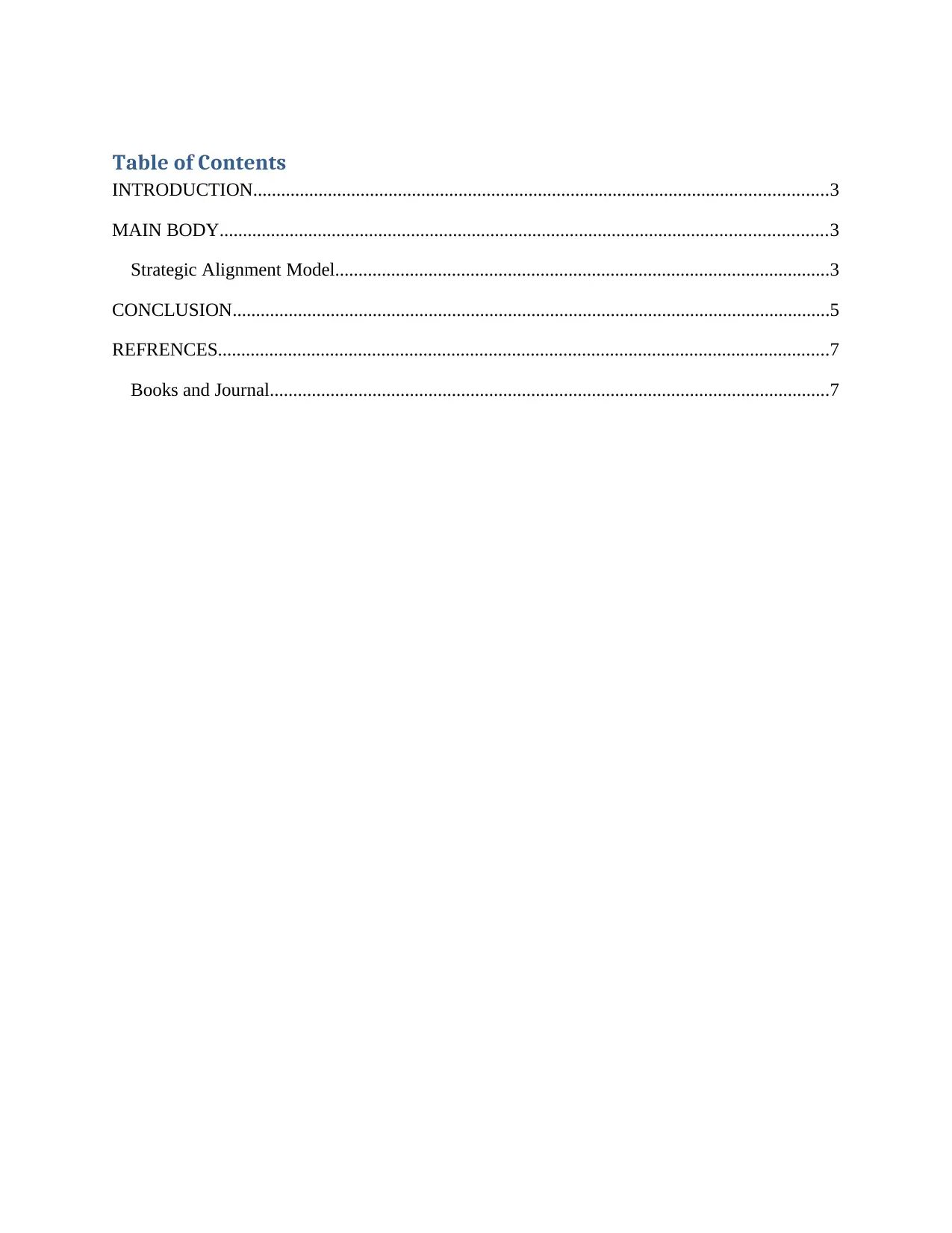
Table of Contents
INTRODUCTION...........................................................................................................................3
MAIN BODY..................................................................................................................................3
Strategic Alignment Model..........................................................................................................3
CONCLUSION................................................................................................................................5
REFRENCES...................................................................................................................................7
Books and Journal........................................................................................................................7
INTRODUCTION...........................................................................................................................3
MAIN BODY..................................................................................................................................3
Strategic Alignment Model..........................................................................................................3
CONCLUSION................................................................................................................................5
REFRENCES...................................................................................................................................7
Books and Journal........................................................................................................................7
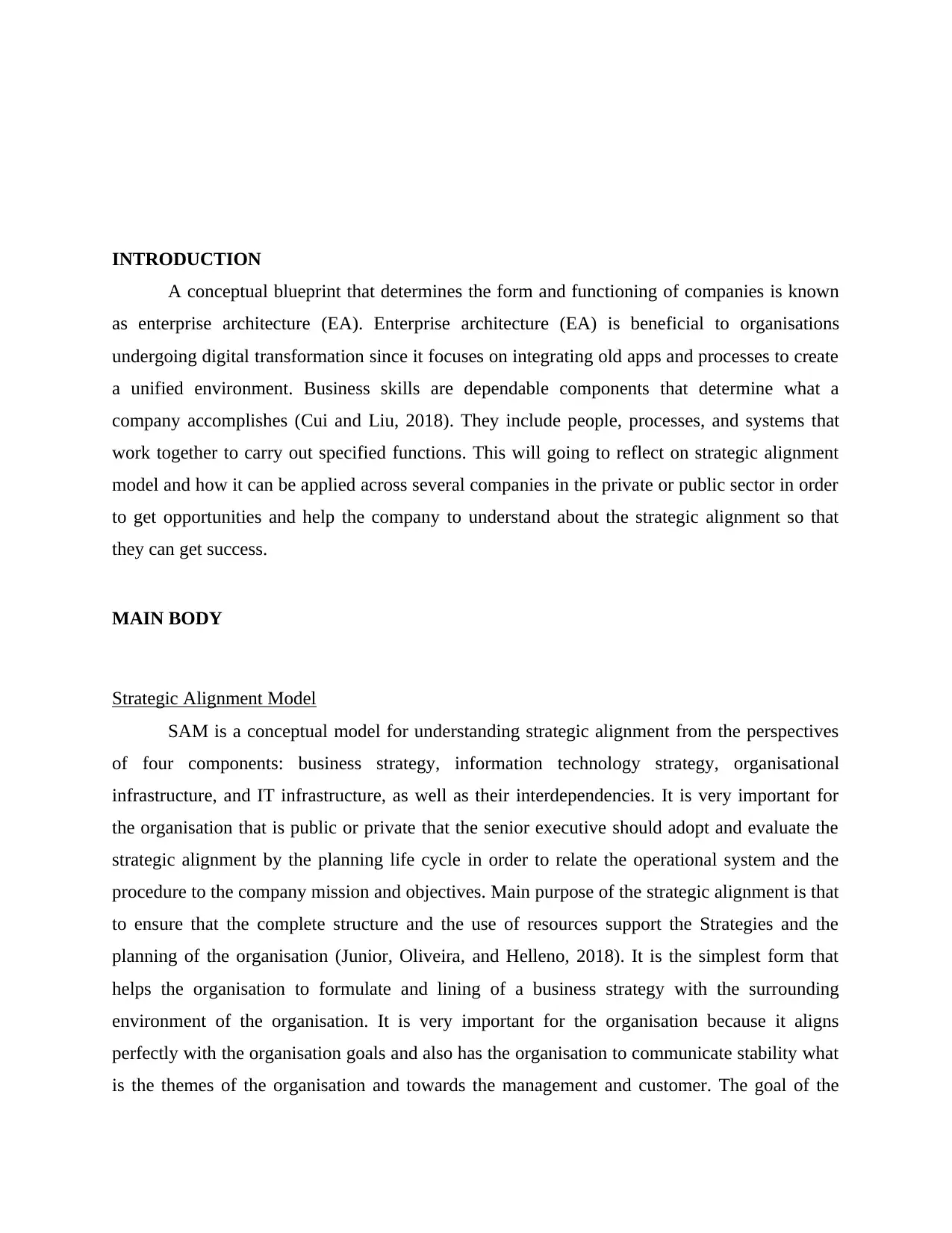
INTRODUCTION
A conceptual blueprint that determines the form and functioning of companies is known
as enterprise architecture (EA). Enterprise architecture (EA) is beneficial to organisations
undergoing digital transformation since it focuses on integrating old apps and processes to create
a unified environment. Business skills are dependable components that determine what a
company accomplishes (Cui and Liu, 2018). They include people, processes, and systems that
work together to carry out specified functions. This will going to reflect on strategic alignment
model and how it can be applied across several companies in the private or public sector in order
to get opportunities and help the company to understand about the strategic alignment so that
they can get success.
MAIN BODY
Strategic Alignment Model
SAM is a conceptual model for understanding strategic alignment from the perspectives
of four components: business strategy, information technology strategy, organisational
infrastructure, and IT infrastructure, as well as their interdependencies. It is very important for
the organisation that is public or private that the senior executive should adopt and evaluate the
strategic alignment by the planning life cycle in order to relate the operational system and the
procedure to the company mission and objectives. Main purpose of the strategic alignment is that
to ensure that the complete structure and the use of resources support the Strategies and the
planning of the organisation (Junior, Oliveira, and Helleno, 2018). It is the simplest form that
helps the organisation to formulate and lining of a business strategy with the surrounding
environment of the organisation. It is very important for the organisation because it aligns
perfectly with the organisation goals and also has the organisation to communicate stability what
is the themes of the organisation and towards the management and customer. The goal of the
A conceptual blueprint that determines the form and functioning of companies is known
as enterprise architecture (EA). Enterprise architecture (EA) is beneficial to organisations
undergoing digital transformation since it focuses on integrating old apps and processes to create
a unified environment. Business skills are dependable components that determine what a
company accomplishes (Cui and Liu, 2018). They include people, processes, and systems that
work together to carry out specified functions. This will going to reflect on strategic alignment
model and how it can be applied across several companies in the private or public sector in order
to get opportunities and help the company to understand about the strategic alignment so that
they can get success.
MAIN BODY
Strategic Alignment Model
SAM is a conceptual model for understanding strategic alignment from the perspectives
of four components: business strategy, information technology strategy, organisational
infrastructure, and IT infrastructure, as well as their interdependencies. It is very important for
the organisation that is public or private that the senior executive should adopt and evaluate the
strategic alignment by the planning life cycle in order to relate the operational system and the
procedure to the company mission and objectives. Main purpose of the strategic alignment is that
to ensure that the complete structure and the use of resources support the Strategies and the
planning of the organisation (Junior, Oliveira, and Helleno, 2018). It is the simplest form that
helps the organisation to formulate and lining of a business strategy with the surrounding
environment of the organisation. It is very important for the organisation because it aligns
perfectly with the organisation goals and also has the organisation to communicate stability what
is the themes of the organisation and towards the management and customer. The goal of the
⊘ This is a preview!⊘
Do you want full access?
Subscribe today to unlock all pages.

Trusted by 1+ million students worldwide
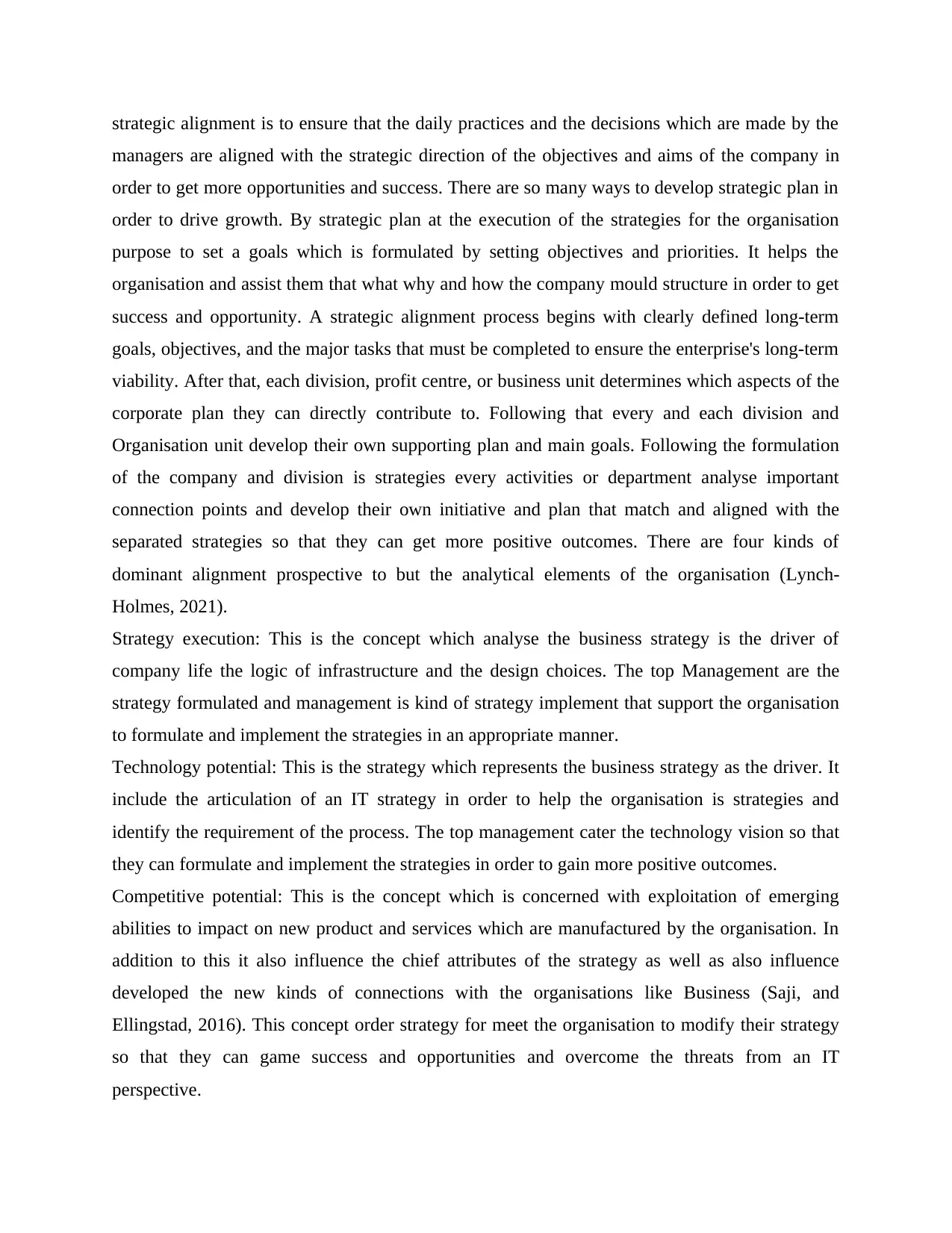
strategic alignment is to ensure that the daily practices and the decisions which are made by the
managers are aligned with the strategic direction of the objectives and aims of the company in
order to get more opportunities and success. There are so many ways to develop strategic plan in
order to drive growth. By strategic plan at the execution of the strategies for the organisation
purpose to set a goals which is formulated by setting objectives and priorities. It helps the
organisation and assist them that what why and how the company mould structure in order to get
success and opportunity. A strategic alignment process begins with clearly defined long-term
goals, objectives, and the major tasks that must be completed to ensure the enterprise's long-term
viability. After that, each division, profit centre, or business unit determines which aspects of the
corporate plan they can directly contribute to. Following that every and each division and
Organisation unit develop their own supporting plan and main goals. Following the formulation
of the company and division is strategies every activities or department analyse important
connection points and develop their own initiative and plan that match and aligned with the
separated strategies so that they can get more positive outcomes. There are four kinds of
dominant alignment prospective to but the analytical elements of the organisation (Lynch-
Holmes, 2021).
Strategy execution: This is the concept which analyse the business strategy is the driver of
company life the logic of infrastructure and the design choices. The top Management are the
strategy formulated and management is kind of strategy implement that support the organisation
to formulate and implement the strategies in an appropriate manner.
Technology potential: This is the strategy which represents the business strategy as the driver. It
include the articulation of an IT strategy in order to help the organisation is strategies and
identify the requirement of the process. The top management cater the technology vision so that
they can formulate and implement the strategies in order to gain more positive outcomes.
Competitive potential: This is the concept which is concerned with exploitation of emerging
abilities to impact on new product and services which are manufactured by the organisation. In
addition to this it also influence the chief attributes of the strategy as well as also influence
developed the new kinds of connections with the organisations like Business (Saji, and
Ellingstad, 2016). This concept order strategy for meet the organisation to modify their strategy
so that they can game success and opportunities and overcome the threats from an IT
perspective.
managers are aligned with the strategic direction of the objectives and aims of the company in
order to get more opportunities and success. There are so many ways to develop strategic plan in
order to drive growth. By strategic plan at the execution of the strategies for the organisation
purpose to set a goals which is formulated by setting objectives and priorities. It helps the
organisation and assist them that what why and how the company mould structure in order to get
success and opportunity. A strategic alignment process begins with clearly defined long-term
goals, objectives, and the major tasks that must be completed to ensure the enterprise's long-term
viability. After that, each division, profit centre, or business unit determines which aspects of the
corporate plan they can directly contribute to. Following that every and each division and
Organisation unit develop their own supporting plan and main goals. Following the formulation
of the company and division is strategies every activities or department analyse important
connection points and develop their own initiative and plan that match and aligned with the
separated strategies so that they can get more positive outcomes. There are four kinds of
dominant alignment prospective to but the analytical elements of the organisation (Lynch-
Holmes, 2021).
Strategy execution: This is the concept which analyse the business strategy is the driver of
company life the logic of infrastructure and the design choices. The top Management are the
strategy formulated and management is kind of strategy implement that support the organisation
to formulate and implement the strategies in an appropriate manner.
Technology potential: This is the strategy which represents the business strategy as the driver. It
include the articulation of an IT strategy in order to help the organisation is strategies and
identify the requirement of the process. The top management cater the technology vision so that
they can formulate and implement the strategies in order to gain more positive outcomes.
Competitive potential: This is the concept which is concerned with exploitation of emerging
abilities to impact on new product and services which are manufactured by the organisation. In
addition to this it also influence the chief attributes of the strategy as well as also influence
developed the new kinds of connections with the organisations like Business (Saji, and
Ellingstad, 2016). This concept order strategy for meet the organisation to modify their strategy
so that they can game success and opportunities and overcome the threats from an IT
perspective.
Paraphrase This Document
Need a fresh take? Get an instant paraphrase of this document with our AI Paraphraser
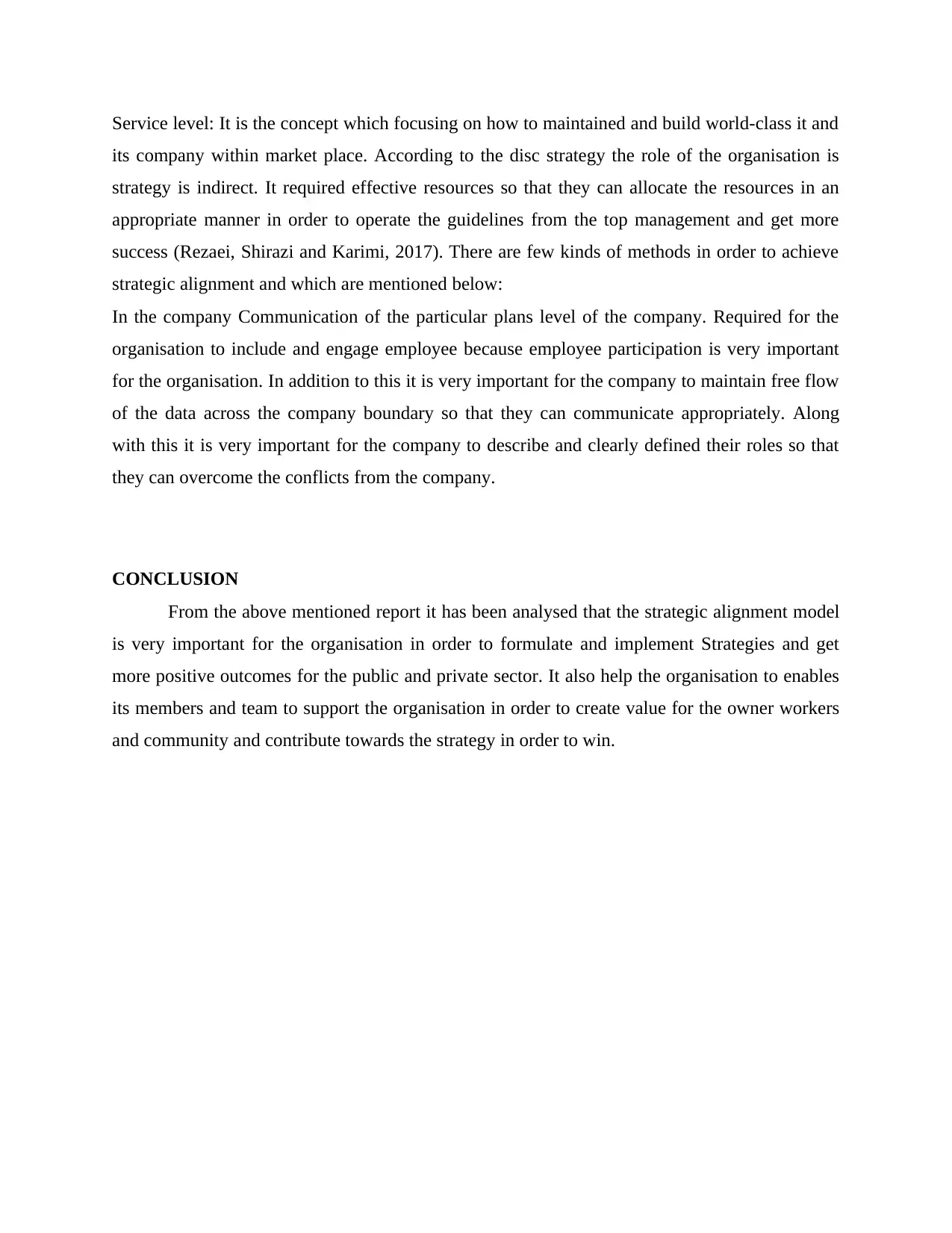
Service level: It is the concept which focusing on how to maintained and build world-class it and
its company within market place. According to the disc strategy the role of the organisation is
strategy is indirect. It required effective resources so that they can allocate the resources in an
appropriate manner in order to operate the guidelines from the top management and get more
success (Rezaei, Shirazi and Karimi, 2017). There are few kinds of methods in order to achieve
strategic alignment and which are mentioned below:
In the company Communication of the particular plans level of the company. Required for the
organisation to include and engage employee because employee participation is very important
for the organisation. In addition to this it is very important for the company to maintain free flow
of the data across the company boundary so that they can communicate appropriately. Along
with this it is very important for the company to describe and clearly defined their roles so that
they can overcome the conflicts from the company.
CONCLUSION
From the above mentioned report it has been analysed that the strategic alignment model
is very important for the organisation in order to formulate and implement Strategies and get
more positive outcomes for the public and private sector. It also help the organisation to enables
its members and team to support the organisation in order to create value for the owner workers
and community and contribute towards the strategy in order to win.
its company within market place. According to the disc strategy the role of the organisation is
strategy is indirect. It required effective resources so that they can allocate the resources in an
appropriate manner in order to operate the guidelines from the top management and get more
success (Rezaei, Shirazi and Karimi, 2017). There are few kinds of methods in order to achieve
strategic alignment and which are mentioned below:
In the company Communication of the particular plans level of the company. Required for the
organisation to include and engage employee because employee participation is very important
for the organisation. In addition to this it is very important for the company to maintain free flow
of the data across the company boundary so that they can communicate appropriately. Along
with this it is very important for the company to describe and clearly defined their roles so that
they can overcome the conflicts from the company.
CONCLUSION
From the above mentioned report it has been analysed that the strategic alignment model
is very important for the organisation in order to formulate and implement Strategies and get
more positive outcomes for the public and private sector. It also help the organisation to enables
its members and team to support the organisation in order to create value for the owner workers
and community and contribute towards the strategy in order to win.
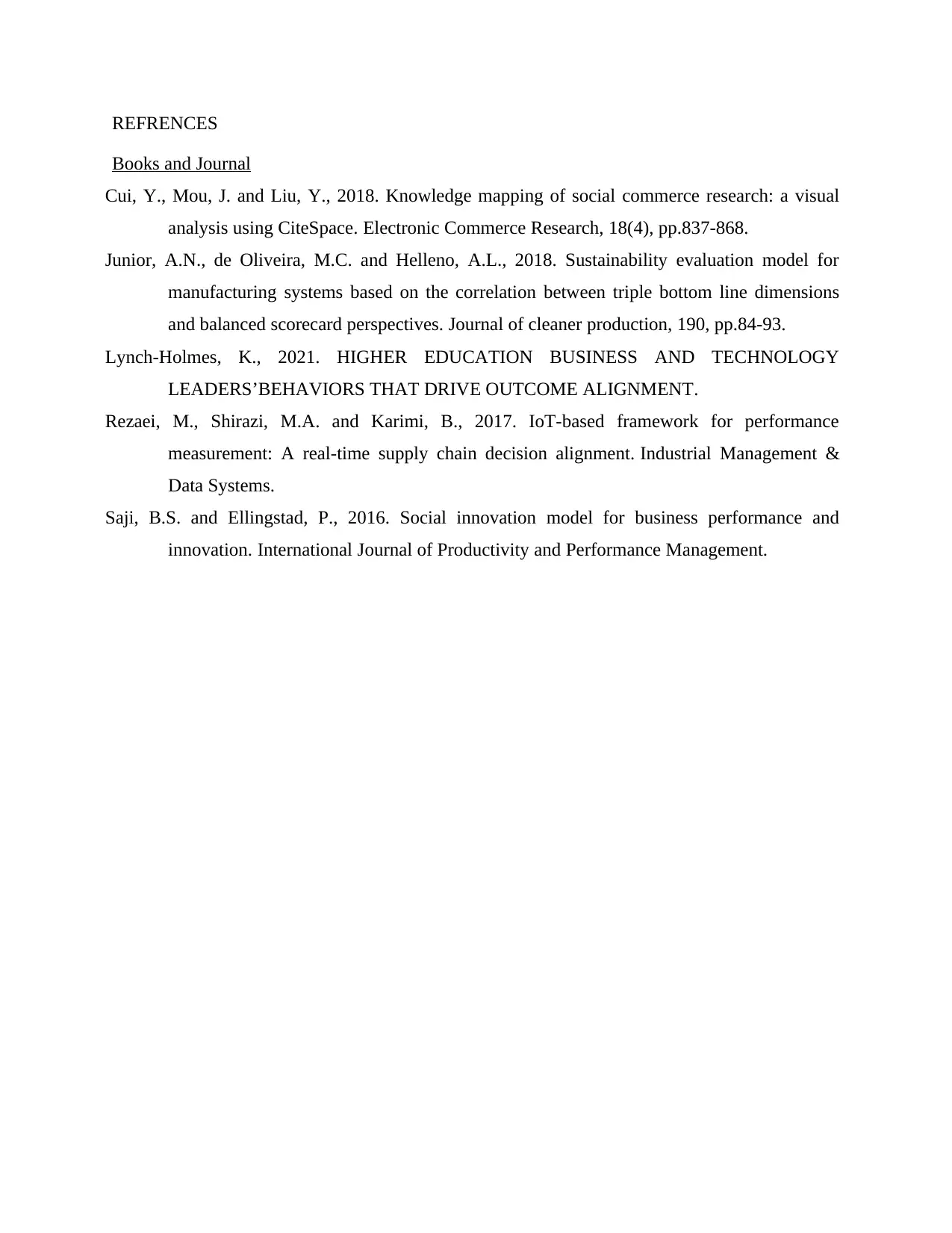
REFRENCES
Books and Journal
Cui, Y., Mou, J. and Liu, Y., 2018. Knowledge mapping of social commerce research: a visual
analysis using CiteSpace. Electronic Commerce Research, 18(4), pp.837-868.
Junior, A.N., de Oliveira, M.C. and Helleno, A.L., 2018. Sustainability evaluation model for
manufacturing systems based on the correlation between triple bottom line dimensions
and balanced scorecard perspectives. Journal of cleaner production, 190, pp.84-93.
Lynch-Holmes, K., 2021. HIGHER EDUCATION BUSINESS AND TECHNOLOGY
LEADERS’BEHAVIORS THAT DRIVE OUTCOME ALIGNMENT.
Rezaei, M., Shirazi, M.A. and Karimi, B., 2017. IoT-based framework for performance
measurement: A real-time supply chain decision alignment. Industrial Management &
Data Systems.
Saji, B.S. and Ellingstad, P., 2016. Social innovation model for business performance and
innovation. International Journal of Productivity and Performance Management.
Books and Journal
Cui, Y., Mou, J. and Liu, Y., 2018. Knowledge mapping of social commerce research: a visual
analysis using CiteSpace. Electronic Commerce Research, 18(4), pp.837-868.
Junior, A.N., de Oliveira, M.C. and Helleno, A.L., 2018. Sustainability evaluation model for
manufacturing systems based on the correlation between triple bottom line dimensions
and balanced scorecard perspectives. Journal of cleaner production, 190, pp.84-93.
Lynch-Holmes, K., 2021. HIGHER EDUCATION BUSINESS AND TECHNOLOGY
LEADERS’BEHAVIORS THAT DRIVE OUTCOME ALIGNMENT.
Rezaei, M., Shirazi, M.A. and Karimi, B., 2017. IoT-based framework for performance
measurement: A real-time supply chain decision alignment. Industrial Management &
Data Systems.
Saji, B.S. and Ellingstad, P., 2016. Social innovation model for business performance and
innovation. International Journal of Productivity and Performance Management.
⊘ This is a preview!⊘
Do you want full access?
Subscribe today to unlock all pages.

Trusted by 1+ million students worldwide
1 out of 6
Related Documents
Your All-in-One AI-Powered Toolkit for Academic Success.
+13062052269
info@desklib.com
Available 24*7 on WhatsApp / Email
![[object Object]](/_next/static/media/star-bottom.7253800d.svg)
Unlock your academic potential
Copyright © 2020–2025 A2Z Services. All Rights Reserved. Developed and managed by ZUCOL.





